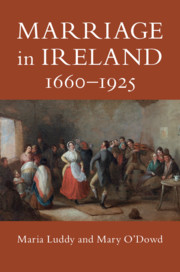Book contents
- Marriage in Ireland, 1660–1925
- Marriage in Ireland, 1660–1925
- Copyright page
- Dedication
- Contents
- Figures
- Illustrations
- Tables
- Acknowledgements
- Abbreviations
- Introduction
- Part I What Is a Marriage?
- Part II Ways to Marriage
- Part III Happy Ever After?
- Part IV The Unmaking of Marriage
- 10 Marital Violence
- 11 Desertion
- 12 Divorce
- Conclusion
- Select Bibliography
- Index
12 - Divorce
from Part IV - The Unmaking of Marriage
Published online by Cambridge University Press: 04 June 2020
- Marriage in Ireland, 1660–1925
- Marriage in Ireland, 1660–1925
- Copyright page
- Dedication
- Contents
- Figures
- Illustrations
- Tables
- Acknowledgements
- Abbreviations
- Introduction
- Part I What Is a Marriage?
- Part II Ways to Marriage
- Part III Happy Ever After?
- Part IV The Unmaking of Marriage
- 10 Marital Violence
- 11 Desertion
- 12 Divorce
- Conclusion
- Select Bibliography
- Index
Summary
This chapter argues that the period is marked by creative legal solutions designed to undermine ecclesiastical control of marital dissolution.The civil courts had begun to consider marriage cases which in 1660 would have been deemed the business of the consistory courts.The canon law prohibition on remarriage after divorce was undermined by private parliamentary acts which dissolved marriages and permitted those involved to remarry.The increasing use of formal and informal private deeds of settlement in which spouses agreed to live apart also weakened strict adherence to church regulations.While these changes did not represent a complete secularisation of Irish marriage law and regulations, they do suggest that men and women were willing to be flexible in their interpretation of church guidelines, particularly when they were considering how to end a problematic union.According to canon law, which guided both the ecclesiastical and civil courts in determining marriage litigation, there were two types of divorce.The first, a vinculo matrimonii(i.e. from the chains of marriage) was, in effect, a judgment that the marriage was null and void because it had never existed in the first place.Far more common in the consistory court and its secular successor were applications for divorce a mensa et thoro or from ‘bed and board’.This was essentially a request for a judicial separation rather than a divorce.Unlike a vinculo matrimonii, a divorce a mensa et thoro did not permit either partner to remarry.
Keywords
- Type
- Chapter
- Information
- Marriage in Ireland, 1660–1925 , pp. 376 - 406Publisher: Cambridge University PressPrint publication year: 2020

